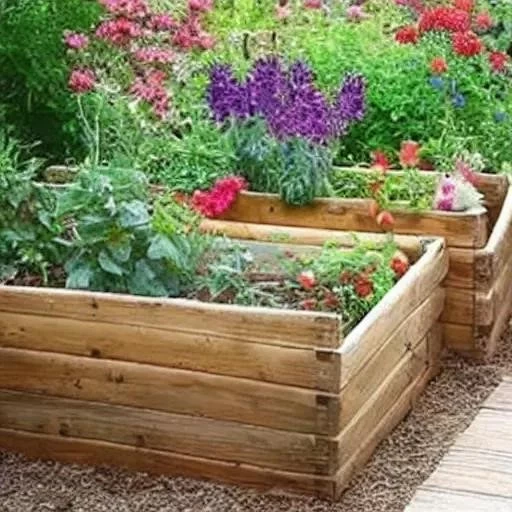In the evolving landscape of modern home aesthetics, where every square foot holds the promise of beauty and utility, the often-overlooked retaining wall is emerging as a breathtaking canvas for horticultural artistry. Far from merely serving a utilitarian purpose of erosion control or leveling uneven terrain, these sturdy structures are now being reimagined as vibrant, cascading flower gardens, transforming mundane barriers into dynamic focal points that elevate curb appeal and delight the senses. This innovative approach to landscaping is not just about planting flowers; it’s about crafting an immersive experience, blending architectural strength with botanical grace to create an outdoor masterpiece that truly captivates.
Imagine a symphony of colors and textures unfurling down a sun-drenched slope, or delicate tendrils of greenery softening the rugged edges of stone, creating an enchanting visual narrative that shifts with the seasons. A thoughtfully designed retaining wall flower garden offers an unparalleled opportunity to inject vertical interest into your outdoor space, maximizing planting areas even in compact urban settings. By strategically incorporating diverse flora, homeowners can not only enhance ecological biodiversity but also establish a private sanctuary, a living artwork that reflects personal style and provides a tranquil retreat from the everyday hustle. This forward-thinking design philosophy promises to redefine what’s possible in garden design, pushing the boundaries of traditional landscaping to create truly unforgettable environments.
| Category | Description |
|---|---|
| Purpose & Function | Retaining walls primarily manage soil erosion and create level terraces on sloped land. When integrated with planting, they transform into aesthetic features that maximize garden space, add vertical interest, and provide unique microclimates for diverse plant life. |
| Common Materials | Popular choices include natural stone (dry-stacked or mortared), concrete blocks (segmented retaining wall systems), timber (treated lumber or railroad ties), and brick. Each material offers distinct aesthetic qualities, durability, and construction requirements. |
| Key Design Principles | Crucial considerations involve proper drainage (gravel backfill, weep holes), structural integrity (adequate foundation, batter), plant compatibility (sunlight, soil depth, root systems), and visual harmony with the surrounding landscape. Terracing multiple walls can create dramatic, multi-level gardens. |
| Benefits of Integration | Beyond structural support, these gardens offer enhanced curb appeal, increased property value, expanded planting opportunities, improved biodiversity, and a unique aesthetic that softens hardscaping. They can also create inviting outdoor living spaces. |
| Recommended Plant Types | Ideal plants include cascading varieties (creeping phlox, alyssum, sedum, petunias, nasturtiums), upright plants for contrast (lavender, ornamental grasses, small shrubs), and drought-tolerant options for upper tiers. Consider sun exposure and soil conditions for optimal growth. |
| Reference Link | Better Homes & Gardens: Retaining Wall Garden Ideas |
Laying the Foundation: Meticulous Planning and Structural Integrity
Before any shovel breaks ground, the journey toward a spectacular retaining wall flower garden begins with an incredibly thorough planning phase. This isn’t just about envisioning pretty flowers; it’s about understanding the engineering marvel beneath the beauty. A successful retaining wall must first and foremost be structurally sound, capable of withstanding the immense lateral pressure of soil and water. Consulting with a landscape architect or structural engineer, particularly for walls exceeding four feet in height, is a profoundly wise investment; They can assess your site’s specific soil composition, potential for water runoff, and frost heave concerns, ensuring your wall’s longevity and stability.
Choosing the right material is another pivotal decision, dictating both the aesthetic and the construction methodology. Natural stone, with its timeless charm and organic appeal, offers unparalleled durability and integrates seamlessly into rustic or traditional landscapes. However, its installation demands skilled masonry. Segmented concrete block systems, conversely, provide a remarkably effective and often more DIY-friendly option, offering a diverse range of textures and colors that can mimic natural stone while providing consistent interlocking stability. For a more contemporary or minimalist feel, gabion walls filled with local stone or even reclaimed materials present an intriguing, permeable solution that offers both structural integrity and unique visual texture. Timber, while generally more economical, requires careful consideration of drainage and treatment to resist rot, a critical factor for its long-term viability.
Cultivating Beauty: The Art of Plant Selection and Placement
Once the structural integrity of your retaining wall is assured, the true artistry of the flower garden begins to unfold. This involves a thoughtful, strategic approach to plant selection, transforming a mere wall into a vibrant, living tapestry. By integrating insights from successful garden designers, we understand that diversity in form, texture, and bloom time is paramount. Consider the wall as a multi-tiered stage, each level offering distinct conditions for different botanical performers. The upper tiers, often drier and more exposed to sunlight, are ideal for drought-tolerant succulents, sun-loving perennials like creeping phlox, sedum, or thyme, whose roots can anchor the soil while their foliage cascades gracefully over the edges, softening the hard lines of the wall.
Moving downwards, where moisture retention might be slightly better and shade more prevalent, opportunities arise for a broader palette of plants. Ferns, hostas, and certain varieties of campanula thrive in these conditions, adding lushness and depth. Introducing plants with varying heights and growth habits creates dynamic interest: upright specimens like ornamental grasses or dwarf shrubs can provide vertical contrast against the trailing plants. Furthermore, think seasonally. Designing for continuous bloom means selecting plants that flower at different times of the year, ensuring your retaining wall flower garden remains a spectacle from early spring through late autumn. This meticulous layering of plant life, considering both aesthetic appeal and ecological function, culminates in a profoundly impactful and endlessly engaging garden.
Sustaining the Splendor: Maintenance for Lasting Vibrancy
A thriving retaining wall flower garden is not a set-it-and-forget-it endeavor; it’s a commitment to ongoing care that yields magnificent rewards. Proper drainage, initially engineered into the wall’s construction, is critical, but regular monitoring is equally important. Ensure weep holes remain clear and that water isn’t pooling at the base, which could compromise the wall’s stability and lead to root rot. Watering routines will depend heavily on your climate and plant choices; frequently, plants in retaining walls, especially those higher up, may dry out faster than ground-level plantings, necessitating more diligent hydration. Employing drip irrigation or soaker hoses can be an incredibly effective and efficient method for delivering water directly to the root zones, minimizing waste and ensuring consistent moisture levels.
Nutrient management also plays a vital role in fostering robust growth and vibrant blooms. Periodically enriching the soil with organic compost or a balanced slow-release fertilizer will provide essential nutrients, invigorating your plants. Pruning and deadheading are not merely aesthetic tasks; they encourage new growth, prolong flowering periods, and maintain the desired shape and density of your plantings, preventing them from becoming leggy or overgrown. Moreover, vigilant pest and disease management, employing organic solutions whenever possible, safeguards the health of your botanical investment. By consistently applying these dedicated maintenance practices, you are not just preserving a garden; you are cultivating a lasting legacy of natural beauty and structural harmony, ensuring your retaining wall flower garden remains a source of immense pride and joy for many years to come.
The Future is Blooming: A Vision of Green Innovation
The concept of the retaining wall flower garden is more than a fleeting trend; it represents a powerful convergence of structural necessity and ecological aspiration. As urban areas densify and homeowners seek innovative ways to connect with nature, these living walls offer a remarkably effective solution to many modern landscaping challenges. They epitomize a forward-thinking approach to sustainable design, mitigating runoff, enhancing local biodiversity, and contributing positively to the microclimate. Imagine entire communities adorned with these vertical gardens, transforming concrete jungles into verdant havens, each wall a testament to human ingenuity and our innate desire for beauty.
This optimistic vision of green innovation is within reach for every homeowner. By embracing the principles of thoughtful design, robust construction, and dedicated care, you can transform an often-overlooked architectural element into a stunning, ecologically beneficial feature. Your retaining wall flower garden will not only be a personal sanctuary but also a vibrant statement, a testament to the transformative power of nature, inspiring neighbors and passersby alike. Step beyond the ordinary and unlock the full, blooming potential of your outdoor space; the future of captivating garden design is quite literally growing upwards.





